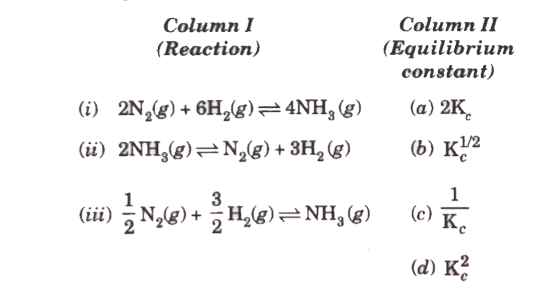Select the reaction for which the equilibrium constant is written as [MX3]2=Keq[MX2]2[X2]
MX3⇔MX2+12X2
2MX3⇔2MX2+X2
2MX2+X2⇔2MX3
MX2+12X2⇔MX3
The correct Answer is:C
To determine the reaction for which the equilibrium constant is expressed as (MX3)2=Keq(MX2)2(X2), we can follow these steps:
Step 1: Understand the Equilibrium Constant Expression
The equilibrium constant Keq for a reaction is given by the ratio of the concentrations of the products raised to the power of their coefficients to the concentrations of the reactants raised to the power of their coefficients.
Step 2: Analyze the Given Expression
The expression provided is:
(MX3)2=Keq(MX2)2(X2)
This can be rearranged to:
Keq=(MX3)2(MX2)2(X2)
This indicates that MX3 is a product and MX2 and X2 are reactants.
Step 3: Write the Balanced Chemical Equation
From the expression, we can infer the balanced chemical equation. Since the concentration of MX3 is squared, it suggests that there are 2 moles of MX3 produced. The reactants MX2 and X2 must combine to form MX3.
Thus, we can write the reaction as:
2MX2+X2⇌2MX3
Step 4: Confirm the Reaction Matches the Expression
Now, we can confirm that this reaction matches the expression for Keq:
- Products: 2MX3 contributes (MX3)2
- Reactants: 2MX2 contributes (MX2)2 and X2 contributes (X2)
Thus, the equilibrium constant expression derived from this reaction is indeed:
Keq=(MX3)2(MX2)2(X2)
Step 5: Identify the Correct Option
Upon reviewing the options provided in the question, the reaction 2MX2+X2⇌2MX3 corresponds to option C.
Final Answer
The correct reaction for which the equilibrium constant is written as (MX3)2=Keq(MX2)2(X2) is:
2MX2+X2⇌2MX3
---
The equilibrium constant Keq for a reaction is given by the ratio of the concentrations of the products raised to the power of their coefficients to the concentrations of the reactants raised to the power of their coefficients.
The expression provided is:
(MX3)2=Keq(MX2)2(X2)
This can be rearranged to:
Keq=(MX3)2(MX2)2(X2)
This indicates that MX3 is a product and MX2 and X2 are reactants.
From the expression, we can infer the balanced chemical equation. Since the concentration of MX3 is squared, it suggests that there are 2 moles of MX3 produced. The reactants MX2 and X2 must combine to form MX3.
2MX2+X2⇌2MX3
Now, we can confirm that this reaction matches the expression for Keq:
- Products: 2MX3 contributes (MX3)2
- Reactants: 2MX2 contributes (MX2)2 and X2 contributes (X2)
Keq=(MX3)2(MX2)2(X2)
Upon reviewing the options provided in the question, the reaction 2MX2+X2⇌2MX3 corresponds to option C.
The correct reaction for which the equilibrium constant is written as (MX3)2=Keq(MX2)2(X2) is:
2MX2+X2⇌2MX3
Topper's Solved these Questions
- BOOK - GRB PUBLICATIONCHAPTER - CHEMICAL EQUILIBRIUMEXERCISE - Reaction Quotient10videos
CHEMICAL EQUILIBRIUM
- BOOK - GRB PUBLICATIONCHAPTER - CHEMICAL EQUILIBRIUMEXERCISE - Degree of Dissociation39videos
CHEMICAL EQUILIBRIUM
- BOOK - GRB PUBLICATIONCHAPTER - ATOMIC STRUCTUREEXERCISE - Subjective Type55videos
ATOMIC STRUCTURE
- BOOK - GRB PUBLICATIONCHAPTER - GASEOUS STATEEXERCISE - Exercise530videos
GASEOUS STATE
Similar Questions
For the reaction
N2(g)+3H2(g)⇔2NH3(g)
Equilibrium constant Kc=[NH3]2[N2][H2]3
Some reactions are written below in column I and their equilibrium constants in terms of Kc are written in Column II. Match the following reactions with the corresponding equilibrium constant.
 View Solution
View SolutionThe equilibrium constant (K) of a reaction may be written as
View Solution
Knowledge Check
- Question 1 - Select One or More
Select the reaction for which the equilibrium constant is written as [MX3]2=K[MX2]2[X2]
AMX3⇔MX2+1/2X2B2MX3⇔2MX2+X2C2MX3+X2⇔2MX3DMX2+1/2X2⇔MX3 - Question 2 - Select One
Select the reaction for which the equilibrium constant is written as
[MX3]2=K[MX2]2[X2]AMX3⇔MX2+1/2X2B2MX3⇔2MX2+X2C2MX2+X2⇔2MX3DMX2+1/2X2⇔MX3 - Question 3 - Select One
Select the reaction for which the equilibrium constant is written as [MX3]2=Keq[MX2]2[X2]
AMX3→MX2+12X2B2MX3→2MX2+X2C2MX2+X2→2MX3DMX2+12X2→MX3
The equilibrium constant (K) of a reaction may be written as
View Solutionstatement-1 : If the equation for a reaction is reversed, the equilibrium constant is inverted and if the equation is multiplied by 2, the equilibrium constant is squared.
statement-2 : The numerical value of an equilibrium constant depends on the way the equation for the reactions is written.View SolutionFor the hypothetical reactions, the equilibrium constant (K) value are given
A⇔B,K1=2,B⇔C,K2=4,
C⇔D,K3=3
The equilibrium constant (K) for the reaction
A⇔D isView SolutionThe equilibrium constant for the reaction
N2+3H2⇔2NH3 is K , then the equilibrium constant for the equilibrium 2NH3⇔N2+3H2 isView SolutionFor the reaction,
I2(aq)⇔I2 (oil), Equilibrium constant is K1.
I2(oil)⇔I2(ether), Equilibrium constant is K2.
I2(aq)⇔I2(ether), Equilibrium constant is K3.
The reaction between K1,K2,K3 isView Solution

